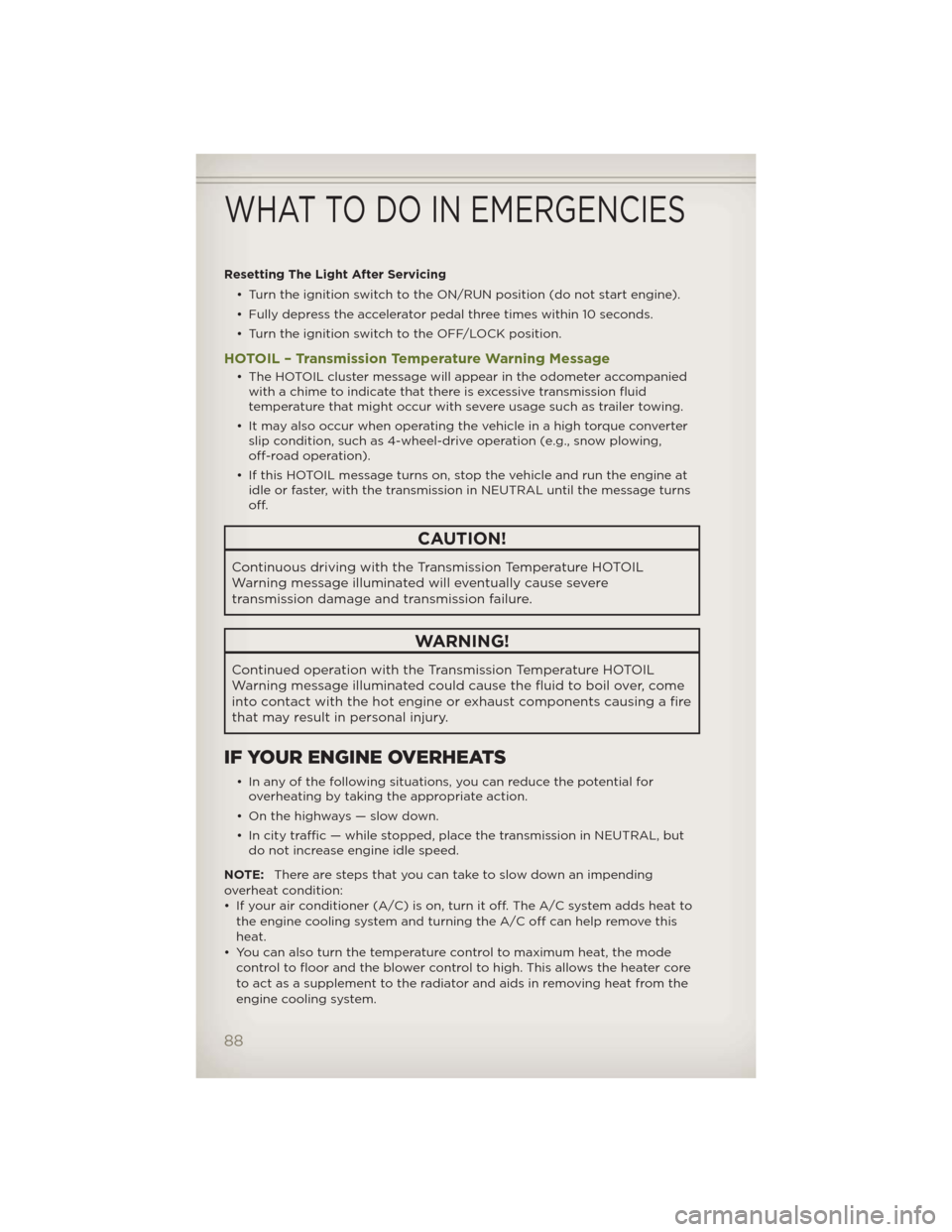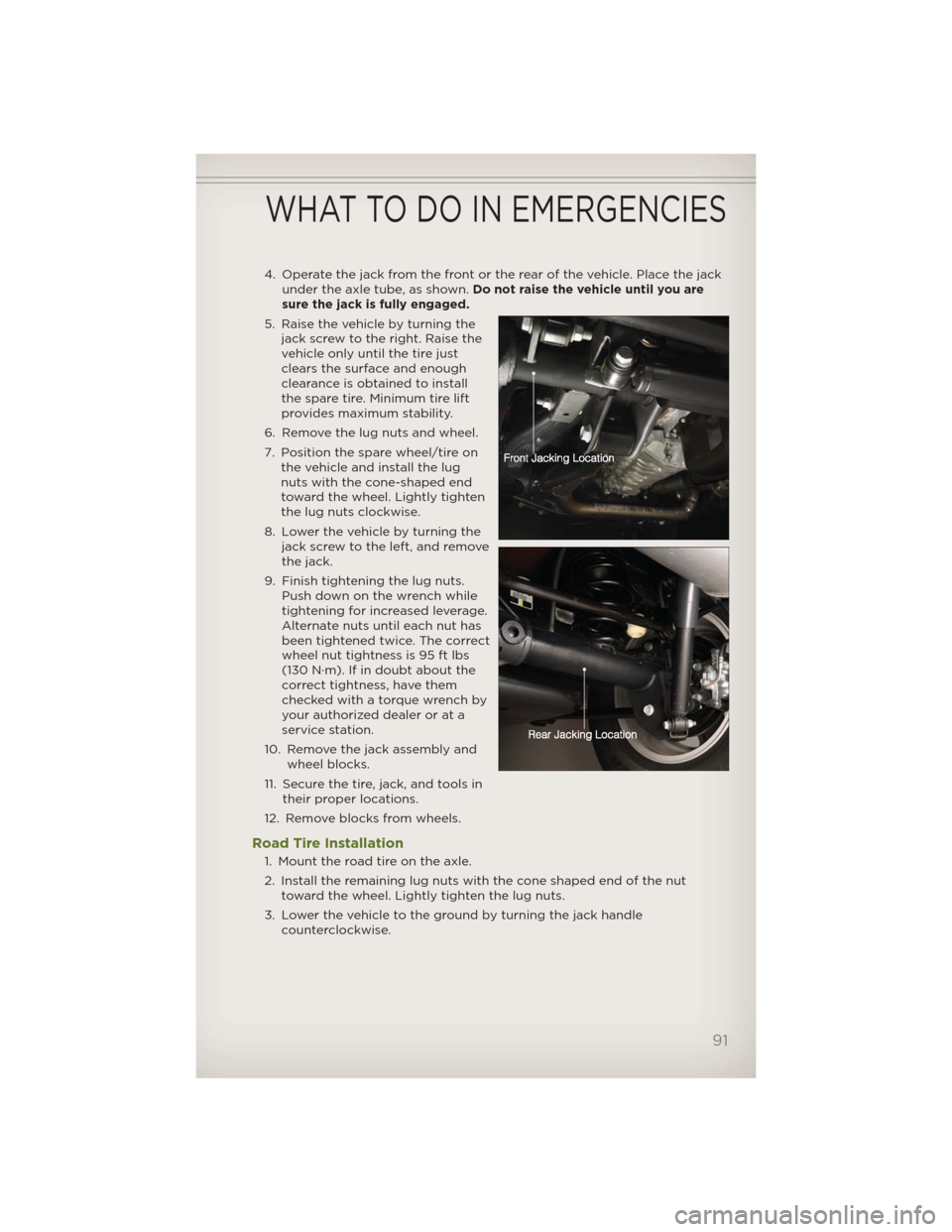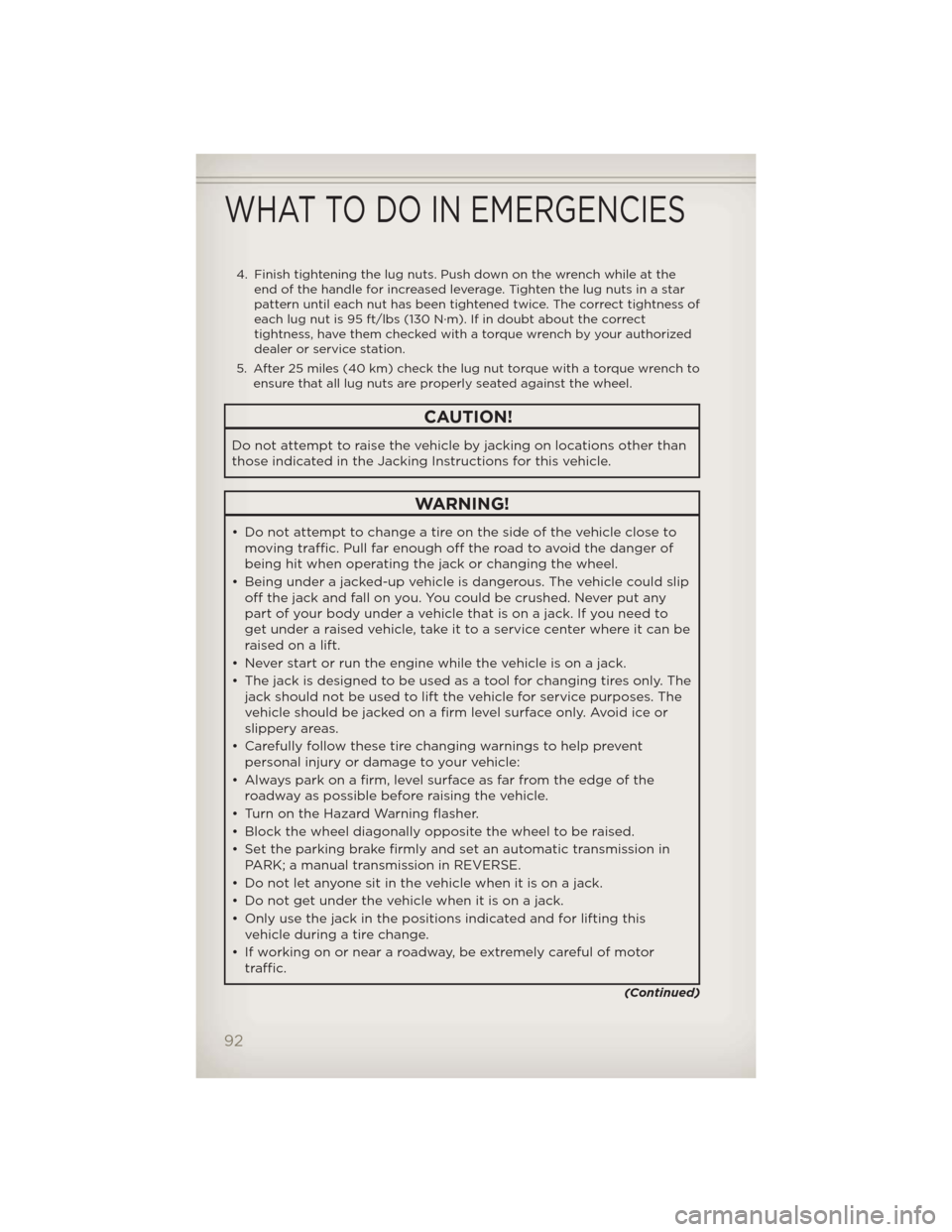torque JEEP WRANGLER 2012 JK / 3.G User Guide
[x] Cancel search | Manufacturer: JEEP, Model Year: 2012, Model line: WRANGLER, Model: JEEP WRANGLER 2012 JK / 3.GPages: 124, PDF Size: 5.48 MB
Page 90 of 124

Resetting The Light After Servicing
• Turn the ignition switch to the ON/RUN position (do not start engine).
• Fully depress the accelerator pedal three times within 10 seconds.
• Turn the ignition switch to the OFF/LOCK position.
HOTOIL – Transmission Temperature Warning Message
• The HOTOIL cluster message will appear in the odometer accompanied
with a chime to indicate that there is excessive transmission fluid
temperature that might occur with severe usage such as trailer towing.
• It may also occur when operating the vehicle in a high torque converter
slip condition, such as 4-wheel-drive operation (e.g., snow plowing,
off-road operation).
• If this HOTOIL message turns on, stop the vehicle and run the engine at
idle or faster, with the transmission in NEUTRAL until the message turns
off.
CAUTION!
Continuous driving with the Transmission Temperature HOTOIL
Warning message illuminated will eventually cause severe
transmission damage and transmission failure.
WARNING!
Continued operation with the Transmission Temperature HOTOIL
Warning message illuminated could cause the fluid to boil over, come
into contact with the hot engine or exhaust components causing a fire
that may result in personal injury.
IF YOUR ENGINE OVERHEATS
• In any of the following situations, you can reduce the potential for
overheating by taking the appropriate action.
• On the highways — slow down.
• In city traffic — while stopped, place the transmission in NEUTRAL, but
do not increase engine idle speed.
NOTE:There are steps that you can take to slow down an impending
overheat condition:
• If your air conditioner (A/C) is on, turn it off. The A/C system adds heat to
the engine cooling system and turning the A/C off can help remove this
heat.
• You can also turn the temperature control to maximum heat, the mode
control to floor and the blower control to high. This allows the heater core
to act as a supplement to the radiator and aids in removing heat from the
engine cooling system.
WHAT TO DO IN EMERGENCIES
88
Page 93 of 124

4. Operate the jack from the front or the rear of the vehicle. Place the jack
under the axle tube, as shown.Do not raise the vehicle until you are
sure the jack is fully engaged.
5. Raise the vehicle by turning the
jack screw to the right. Raise the
vehicle only until the tire just
clears the surface and enough
clearance is obtained to install
the spare tire. Minimum tire lift
provides maximum stability.
6. Remove the lug nuts and wheel.
7. Position the spare wheel/tire on
the vehicle and install the lug
nuts with the cone-shaped end
toward the wheel. Lightly tighten
the lug nuts clockwise.
8. Lower the vehicle by turning the
jack screw to the left, and remove
the jack.
9. Finish tightening the lug nuts.
Push down on the wrench while
tightening for increased leverage.
Alternate nuts until each nut has
been tightened twice. The correct
wheel nut tightness is 95 ft lbs
(130 N·m). If in doubt about the
correct tightness, have them
checked with a torque wrench by
your authorized dealer or at a
service station.
10. Remove the jack assembly and
wheel blocks.
11. Secure the tire, jack, and tools in
their proper locations.
12. Remove blocks from wheels.
Road Tire Installation
1. Mount the road tire on the axle.
2. Install the remaining lug nuts with the cone shaped end of the nut
toward the wheel. Lightly tighten the lug nuts.
3. Lower the vehicle to the ground by turning the jack handle
counterclockwise.
WHAT TO DO IN EMERGENCIES
91
Page 94 of 124

4. Finish tightening the lug nuts. Push down on the wrench while at the
end of the handle for increased leverage. Tighten the lug nuts in a star
pattern until each nut has been tightened twice. The correct tightness of
each lug nut is 95 ft/lbs (130 N·m). If in doubt about the correct
tightness, have them checked with a torque wrench by your authorized
dealer or service station.
5. After 25 miles (40 km) check the lug nut torque with a torque wrench to
ensure that all lug nuts are properly seated against the wheel.
CAUTION!
Do not attempt to raise the vehicle by jacking on locations other than
those indicated in the Jacking Instructions for this vehicle.
WARNING!
• Do not attempt to change a tire on the side of the vehicle close to
moving traffic. Pull far enough off the road to avoid the danger of
being hit when operating the jack or changing the wheel.
• Being under a jacked-up vehicle is dangerous. The vehicle could slip
off the jack and fall on you. You could be crushed. Never put any
part of your body under a vehicle that is on a jack. If you need to
get under a raised vehicle, take it to a service center where it can be
raised on a lift.
• Never start or run the engine while the vehicle is on a jack.
• The jack is designed to be used as a tool for changing tires only. The
jack should not be used to lift the vehicle for service purposes. The
vehicle should be jacked on a firm level surface only. Avoid ice or
slippery areas.
• Carefully follow these tire changing warnings to help prevent
personal injury or damage to your vehicle:
• Alwayspark on a firm, level surface as far from the edge of the
roadway as possible before raising the vehicle.
• Turn on the Hazard Warning flasher.
• Block the wheel diagonally opposite the wheel to be raised.
• Set the parking brake firmly and set an automatic transmission in
PARK; a manual transmission in REVERSE.
• Do not let anyone sit in the vehicle when it is on a jack.
• Do not get under the vehicle when it is on a jack.
• Only use the jack in the positions indicated and for lifting this
vehicle during a tire change.
• If working on or near a roadway, be extremely careful of motor
traffic.
(Continued)
WHAT TO DO IN EMERGENCIES
92